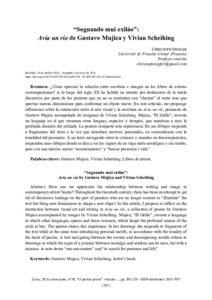Por favor, use este identificador para citar o enlazar este ítem:
https://repositorio.uca.edu.ar/handle/123456789/18843| Campo DC | Valor | Lengua/Idioma |
|---|---|---|
| dc.contributor.author | Singler, Christoph | es |
| dc.date.accessioned | 2024-09-26T13:33:12Z | - |
| dc.date.available | 2024-09-26T13:33:12Z | - |
| dc.date.issued | 2024 | - |
| dc.identifier.issn | 0326-3363 (impreso) | - |
| dc.identifier.issn | 2683-7897 (online) | - |
| dc.identifier.uri | https://repositorio.uca.edu.ar/handle/123456789/18843 | - |
| dc.description.abstract | ¿Cómo apreciar la relación entre escritura e imagen en los libros de artistas contemporáneos? A lo largo del siglo XX ha habido un intento por deshacerse de la tutela discursiva por parte de los pintores que ya no se contentan con “ilustrar” el texto sino que aportan nuevas dimensiones para conformar un objeto nuevo. En este artículo, me propongo reflexionar sobre la interacción entre el arte visual y la escritura en Avía un río, poemario de Gustavo Mujica acompañado de imágenes de Vivian Scheihing. Mujica, “El Grillo”, inventa un lenguaje en el que resuenan otras lenguas, espacios y tiempos, que mantiene a raya la profunda desazón del exiliado. La pintora comparte esta experiencia. En sus dibujos responde a fragmentos del texto a la vez que introduce motivos personales, en concordancia con la tonalidad del poemario. A un texto navegando entre lo cósmico y mundos en descomposición, responden unos dibujos donde se dan a ver los signos de un viaje entre nostálgico y sin rumbo, pero con una misión: anotar “neoencuentros” y “buscar presencia i vida”. | es |
| dc.description.abstract | How can we appreciate the relationship between writing and image in contemporary artists' books? Throughout the twentieth century, there has been an attempt to get rid of discursive tutelage on the part of painters who are no longer content to “illustrate” the text but bring new dimensions to shape a new object. In this article, I propose to reflect on the interaction between visual art and writing in Avía un río, a collection of poems by Gustavo Mujica accompanied by images by Vivian Scheihing. Mujica, “El Grillo”, invents a language in which other languages, spaces and times resonate, which keeps the profound unease of the exile at bay. The painter shares this experience. In her drawings she responds to fragments of the text while at the same time introducing personal motifs, in accordance with the tonality of the book of poems. A text navigating between the cosmic and decomposing worlds relates to drawings in which the signs of a journey between nostalgic and aimless can be seen, but with a mission: to note down “neo-encounters” and “to search for presence and life”. | es |
| dc.format | application/pdf | es |
| dc.language.iso | spa | es |
| dc.publisher | Pontificia Universidad Católica Argentina. Facultad de Filosofía y Letras. | es |
| dc.rights | Atribución-NoComercial-CompartirIgual 4.0 Internacional | * |
| dc.rights | Atribución-NoComercial-CompartirIgual 4.0 Internacional | * |
| dc.rights.uri | http://creativecommons.org/licenses/by-nc-sa/4.0/ | * |
| dc.source | Letras 2024 (89) | es |
| dc.subject | Mujica, Gustavo, 1948- | es |
| dc.subject | Scheihing, Vivian, 1947- | es |
| dc.subject | LITERATURA CHILENA | es |
| dc.subject | PINTURA | es |
| dc.subject | ARTE VISUAL | es |
| dc.subject | POESIA CHILENA | es |
| dc.title | “Sognando mui exiláo”: Avía un río de Gustavo Mujica y Vivian Scheihing | es |
| dc.title | “Sognando mui exiláo”: Avía un río by Gustavo Mujica and Vivian Scheihing | es |
| dc.type | Artículo | es |
| dc.identifier.doi | 10.46553/LET.89.2024.p205-220 CC-BY-NC-SA 4.0 | - |
| uca.disciplina | LITERATURA | es |
| uca.issnrd | 1 | es |
| uca.affiliation | Fil: Singler, Christoph. Université de Franche-Comté; Francia | es |
| uca.version | publishedVersion | es |
| item.languageiso639-1 | es | - |
| item.fulltext | With Fulltext | - |
| item.grantfulltext | open | - |
| Aparece en las colecciones: | LETRAS - 2024 nro. 89 - “Ut pictura poesis”: vínculos contemporáneos entre arte y literatura | |
Ficheros en este ítem:
| Fichero | Descripción | Tamaño | Formato | |
|---|---|---|---|---|
| Sognando_mui_exilao.pdf | 1,07 MB | Adobe PDF |  Visualizar/Abrir |
Este ítem está sujeto a una Licencia Creative Commons

